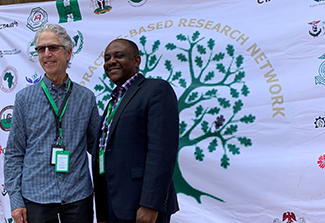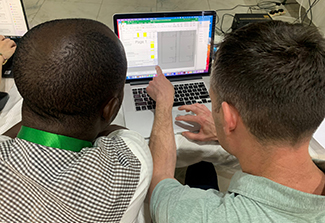“Why can’t you help?” Developing research infrastructure in Nigeria
March/April 2024 | Volume 23 Number 2
By Susan Scutti
 Photo courtesy of Nicole JoyceGreg Aarons (left) and Eche Ezeanolue (right) celebrate their partnership in front of the NISA banner.
Photo courtesy of Nicole JoyceGreg Aarons (left) and Eche Ezeanolue (right) celebrate their partnership in front of the NISA banner.
A handful of forthright words spurred Dr. Echezona Ezeanolue to reconsider his career. In 2010, he was a Robert Wood Johnson Health Policy Fellow in the office of Kathleen Sebelius, then U.S. Secretary of Health and Human Services. “They were talking about how, despite all the money spent in Nigeria by the U.S., it was one of four countries where HIV testing among pregnant women was less than 20%. So, the secretary turned to me and said, ‘You're from Nigeria—why can't
you help?’”
At that time Ezeanolue’s appointment was at the University of Nevada, Las Vegas and all his research was U.S.-based. Yet he left Sibelius’ office determined to work in Nigeria. Soon after, he applied for and received a grant jointly funded by the
Eunice Kennedy Shriver National Institute of Child Health and Human Development (NICHD), Fogarty and the U.S. President’s Emergency Plan for AIDS Relief (PEPFAR) studying mother-to-child HIV transmission.
“I went back to Nigeria, and saw Harvard was there, University of Maryland was there, Vanderbilt was there—many U. S. institutions were there. So, I thought,
This isn’t a problem of expertise, but one of culture.” He called all of them and asked,
What’s the issue? “They told me they couldn’t find pregnant women.” He smiled ruefully as he recalled thinking,
How can you not find pregnant women? Turns out, they’d set up their programs in health institutions as they would do in the U.S. Yet, unlike the U.S., only about a third of Nigerian women deliver in health facilities. The number of women willing to participate in each program was insufficient for creating study cohorts.
Community orientation
To work with women on their own terms, Ezeanolue started a community-based intervention in 40 neighborhoods and villages. He decided to offer additional services since he knew HIV/AIDS was highly stigmatized. This way, he’d attract more participants. “We called the pregnant women and asked them what else could we offer them. The first thing they mentioned was nutrition during pregnancy, what could they eat if they couldn’t afford multivitamins?” (Ripe plantains can provide iron during pregnancy.)
“The second thing [the mothers asked about] was sickle cell checkups,” said Ezeanolue, noting Nigeria has the highest number of people in the world born with sickle cell disease. “Then we asked the men what they wanted, since they drive the women to (and pay for) health care.” The men wanted anemia check-ups. “So we added hemoglobin testing. And, in Nigeria, the number one cause of disability is stroke from undiagnosed and uncontrolled hypertension, so we added blood pressure to our list. Finally, we included depression screening.”
Ezeanolue’s first project in Nigeria yielded 25 publications. “We had data on HIV, anemia, sickle cell, hypertension, and depression. We found out 35% of the people diagnosed with hypertension didn't even know they had hypertension.” Since that project, he’s acquired an additional role at University of Nigeria Nsukka (UNN) and conducted several NIH-funded studies in Nigeria, including
Strengthening Research Administration Infrastructure for HIV Research, a Fogarty G-11 project that is still underway.
Laying the groundwork for research infrastructure
One of the world’s largest HIV epidemics exists in Nigeria; 1.8 million people there live with HIV. The U.S. government has made substantial investments in HIV care and research in Nigeria, and UNN College of Medicine has implemented multiple projects, but only as a sub-awardee. While 93% of researchers at UNN expressed interest in submitting grant applications, only 28% knew where to get research administration support, a needs assessment found. Ezeanolue’s project, a partnership between UNN and University of California, San Diego (UCSD), aims to further develop, professionalize, and reinforce research administration and management infrastructure at UNN so that it can become a primary grant recipient.
Dr. Gregory Aarons, a professor at UCSD, is a principal investigator (PI) on this G-11 project. “I was doing training on implementation science for Fogarty in sub-Saharan Africa and I got to meet many researchers, including Eche Ezeanolue,” recalled Aarons. (Ezeanolue made the most of this first encounter, immediately asking Aarons to work with him on the “baby shower initiative,” a study evaluating delivery of HIV services at churches.)
“I became very interested in Eche’s community-based research approach for implementing HIV prevention and treatment for pregnant women.”
Ezeanolue developed his singular research approach following a network meeting organized by Fogarty’s Dr. Rachel Sturke and NICHD’s Dr. George Siberry. Sturke and Siberry had asked the HIV investigators a meeting in South Africa to bring along one of their collaborators; Ezeanolue arrived with a church bishop and Nigeria’s CDC director. “When I saw how that meeting was organized—how it was a platform to share—I recognized that there’s a gap in Nigeria,” said Ezeanolue. In his experience, Nigerian scientists had to go outside the country to learn what’s happening inside the country. Returning to Nigeria, he immediately called all the PEPFAR-funded investigators there to discuss forming a platform—an alliance for implementation research.
 Photo courtesy of Nicole JoyceStephan Orafa (left), UNN-CTAIR, works with Neil Dutcher, UCSD, to learn how to develop a detailed budget for a proposal submission
Photo courtesy of Nicole JoyceStephan Orafa (left), UNN-CTAIR, works with Neil Dutcher, UCSD, to learn how to develop a detailed budget for a proposal submission
NISA, an engine for growth
The Nigerian Implementation Science Alliance (NISA) has three main focuses, he explained. First, NISA develops infrastructure to conduct clinical trials and implementation science. Second, it builds a cadre of well-educated research staff. Third, NISA brings together investigators, policymakers, NGO staff, and others to share ideas and learn what researchers have already done, so they can avoid repeating what hadn’t worked, while adopting and scaling up what had.
“We decided not to ask NIH for funding because we wanted to build something sustainable,” he said. “That made everybody laugh.” Seemingly, only Sturke and Siberry took him seriously. “They promised to support us informally (since we weren’t funded by them), and we organized our first meeting in 2015. Both came and that was the start of NISA.”
Today, NISA rests on four pillars: weekly research-in-progress meetings; monthly webinars; quarterly research sharing weeks; and a yearly conference. Aarons, a NISA conference keynote speaker over multiple yeas, said, “I was really impressed with the ability of Eche and the UNN team to bring people from across Nigeria and other West African countries to NISA, where people could learn about implementation science and how it can accelerate adoption of evidence-based treatments and prevention approaches.” Aarons also saw how the first-of-its-kind practice-based research network developed from NISA could build on the G-11-funded program in developing research capacity.
Ezeanolue explained, “We selected two sites from each of the country’s six regions and made them what we call ‘implementation laboratories.’ If we implement something in two sites in every region and it works, then each of those sites will become model innovation centers to help scale-up regionally.” Ezeanolue is director of UNN’s
Center for Translation and Implementation Science (CTAIR), the network’s organizing hub. His and Aaron’s G-11 grant, then, aims to strengthen the research administration infrastructure of UNN and CTAIR.
The grant requires training 12 people in research administration. Aarons said, “We cast a wide net to look for who was really poised to be in those administration roles. We didn't want to train people if they weren't going to actually go back and practice.” Then they brought in an additional 12 people, doubling the number of trainees. "Remember the 12 network sites, two in each region?” Ezeanolue asked. “We’re also training one community research engagement officer from each of those sites. These are the people who go to the church, the mosque, the community, and talk about the research we're about to do, why it's important and why people should participate.”
Integrating administration and research training
Nicole Joyce, a UCSD research administrator, had never met Aarons before receiving an email from him in 2020, requesting information about her program. “In our first meeting, it slowly dawned on me that he didn’t want to just send staff to my training—he was asking me to co-develop a capacity building program with UNN.” She immediately felt intimidated. “Administrators don’t cross over to the research side very often.” However, Joyce’s infectious enthusiasm for research administration was clear to Aarons, who believed this could be a great opportunity for her to make a difference in global health.
Joyce’s training strategy is anchored to the research administration life cycle: “So we look pre-award activities, post-award activities, compliance activities, and the systems, tools and resources researchers need to perform those activities.” Though Joyce began her UNN training in the usual way, she quickly learned to adapt to the realities of Nigeria’s infrastructure. “They commonly have power outages and unreliable Internet. Some trainees didn't have laptops, software, or tech skills.” When they trained on-site in Enugu, Nigeria, the team encountered unexpected hurdles when SAM (the U.S. government system for awards management) couldn’t “talk to” another system. “A little technical challenge around an address character limitation ended up costing us nine months and not being able to pay a sub-awardee.”
Nevertheless, the team scored undeniable triumphs. Notably, a National Cancer Institute research grant awarded to Aarons and Ezeanolue alongside the G-11 project helped provide the trainees with much needed real-world experience. Aarons said, “We're developing a sense of collaboration. The administrators feel they're part of something important… because they are. ”Hands-on coaching and mentoring continue during the project’s second year via weekly, sometimes daily calls." He added, “Through everyone's enthusiasm, it’s going way beyond what we proposed—it’s building not just UNN’s infrastructure but a nation's infrastructure.”
More Information
- Related Fogarty grant:
Strengthening Research Administration Infrastructure for HIV Research in Nigeria
-
Echezona Ezeanolue, MD, MPH, biography via Center for Translation and Implementation Science (CTAIR)
-
Greg Aarons, PhD, biography via the University of California San Diego
-
Profile of Nicole Joyce, MBA, director of sponsored research administration, Business Intelligence Systems and Innovation Strategies at UCSD
-
The baby shower initiative,
Annals of Global Health, September 25, 2014
Updated April 16, 2024
To view Adobe PDF files,
download current, free accessible plug-ins from Adobe's website.
Related Fogarty Programs
Related World Regions / Countries
Related Global Health Research Topics